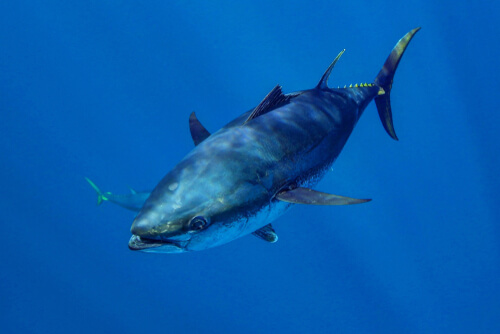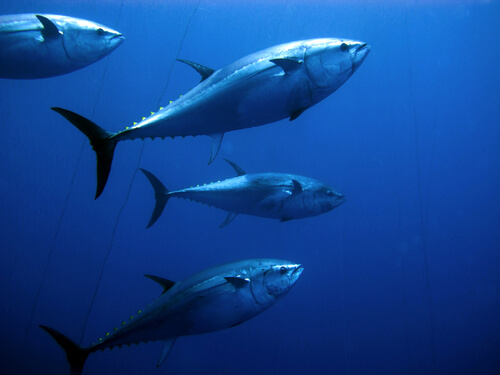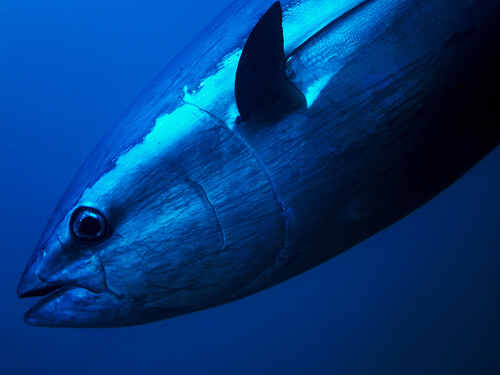
| Kingdom | Animalia |
| Phylum | Chordata |
| Class | Actinopterygii |
| Order | Scombriformes |
| Family | Scombridae |
| Genus | Thunnus |
| Species | T. thynnus, T. orientalis, T. maccoyii |
| Niche | Epipelagic predator |
| Length | 6-10 ft (2-3 m) |
| Weight | 1,500 lbs (680 kg) |
| Lifespan | 50 years |
| Social Structure | Schooling predator |
| Conservation Status | Endangered |
| Preferred Habitat | Surface waters and up to 3,000 feet |
| Average Clutch Size | Millions of eggs |
| Main Food Items and Prey | Fish, crustaceans, squids, etc. |
| Predators | False killer whale, mako shark, great white shark |
The Basics
Bluefin tuna refers to three species of closely related tuna known commonly as the Atlantic, Pacific, and Southern bluefin tuna. The Atlantic bluefin (Thunnus thynnus) is the largest and most common, growing up to 10 feet in length and weighing up to 1,500 pounds or more. The Pacific bluefin tuna (Thunnus orientalis) and Southern bluefin (Thunnus maccoyii) are closely related species with mostly distinct distributions and ranges.
Description
Bluefin tunas are streamlined, torpedo-shaped predatory fish. They can grow to impressive sizes, with the Atlantic bluefin growing as heavy as 1,500 pounds and up to 10 feet long. They have large tails, a conical head with a large mouth, and a dorsal and anal fin. Bluefins also have two pectoral fins that are relatively short in comparison with other species of tuna. Like other tuna, they also have small finlets along their hind section between their tail fin and dorsal and anal fins. They are generally a combination of blue shades, changing to a silvery colour on the underside of the animal.

Distribution and Habitat
The Atlantic bluefin tuna ranges throughout the Atlantic Ocean as well as the Mediterranean Sea. Historically, they also inhabited the Black Sea but are now extinct there. The Pacific bluefin tuna is present in much of the pacific ocean, with known breeding grounds in the northeastern Philippine Sea as well as the Sea of Japan. They are also known to migrate to the East Pacific and beyond but will return to these spawning locations after several years. The southern bluefin tuna can be found throughout the southern hemisphere, with a known spawning area in the Indian Ocean near the Indonesian island of Java.
Bluefin tuna are mostly pelagic, spending their time in deep, offshore waters. Unlike the yellowfin tuna which spends most of its time near the surface, most bluefins are known to regularly dive to great depths of more than 3,000 feet.
Diet
Bluefin tuna are predatory fish, using their speed and strength to strike rapidly at a variety of prey species. They often attack smaller schooling fish such as sardines and mackerel. Other commonly consumed fish species include herring and juvenile individuals of larger fish such as other tuna. Bluefins also consume a variety of invertebrate species such as squid, which they may hunt at depth in the daytime or nearer the surface waters at night when the squid ascend to hunt themselves. Pelagic crustaceans such as crabs, lobsters, crayfish, and shrimp are also common prey species of bluefin tuna.
Reproduction
Like other tuna species, bluefin tuna spawn throughout the year in specific areas depending on the species and stock. The Atlantic bluefin tuna, for example, spawns in only two areas, including the western Mediterranean Sea and the Gulf of Mexico, in the western Atlantic. Females are capable of producing up to 30 million eggs at a time, which they will broadcast into the water column in conjunction with males, which will release their sperm into the water column, allowing for external fertilization of the embryos.

Like many fish species, larval bluefin tuna will develop as part of the zooplankton community, traveling the oceans at the whim of currents and ocean upwellings. Eventually, once developed into juvenile tuna, they will begin schooling with other similarly-sized fish, including other species of tuna in some instances. After 2-5 years depending on the subpopulation, the bluefin tuna reaches sexual maturity. These species are relatively long-lived, with some Atlantic bluefin tuna believed to reach the age of 50 years or more.
Conservation Status
The bluefin tuna is a highly valuable target of commercial fisheries. In fact, the fishery for the Atlantic bluefin may be the most lucrative in the world. It is a highly desirable species for the Japanese market, where it is used for sashimi and sushi. It is also a popular sport fishery, with a long history as a big-game target dating back to the 1930s.

Due to this lucrative fishery, exploitation and overfishing of the species has occurred, leading to the reduction of the wild bluefin tuna stock by more than 80% in some parts of its range. Indeed the Atlantic bluefin tuna is now listed as Endangered on the IUCN Red List of Threatened Species.
Fun Facts about the Bluefin Tuna!
As one of the most valuable species of fish commercially and one of the largest fish species in the world, the bluefin tuna leaves no shortage of fun facts and interesting biological concepts and insights to explore.
Tuna-eyed
Although tunas are well known for their powerful, streamlined, bodies, and impressive swimming speeds, they are also equipped with additional tools that help them to be such effective predators. For example, they hunt by sight and have very good vision. In fact, tunas likely have the sharpest vision of any species of bony fish. This vision also allows them to school with great coordination.
Hot and Ready
The bluefin tuna in particular is very muscular and strong. This power is directed through a pair of tendons to its tail fin for propulsion. Unlike other fish species, the body of tunas remains rigid while their tail flicks back and forth. This reduces drag and increases the efficiency of each swimming stroke, contributing to the tunas’ impressive swimming velocities. In order to be responsive when required, these muscles need to be kept warm and ready for intense use on demand.
Indeed, tunas are known as endotherms, or ‘warm-blooded’. This allows them to keep their large swimming muscles warm, as required for their effective use. This occurs via the use of what is known as countercurrent exchange, where warm blood traveling in veins away from the heart is transferred to the colder blood traveling in arteries towards the heart. All members of the tuna family are endotherms. However, this evolutionary adaptation is more highly developed in the bluefin tuna than in other tuna species, allowing them to access the highly productive waters of the North Atlantic.
Don’t Forget the Oxygen
Although keeping their muscles as warm as possible is important in allowing tuna to react quickly when prey or predator dictates the need. However, it is also important that they muscles remain highly oxygenated as well.
In addition to their ability to retain heat, bluefin tunas also have a highly efficient circulatory system. In fact, among all species of fish, it possesses one of the highest concentrations of hemoglobin in its blood. This increased ability to carry oxygen in its bloodstream in combination with a particularly thin blood-water barrier allows it to keep its tissues more oxygenated than would otherwise be possible without these specific adaptations.
